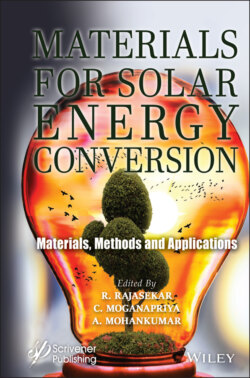Читать книгу Materials for Solar Energy Conversion - Группа авторов - Страница 2
Table of Contents
Оглавление1 Cover
2 Title page
3 Copyright
4 Preface
5 Part 1 SOLAR CELLS - FUNDAMENTALS AND EMERGING CATEGORIES 1 Introduction to Solar Energy Conversion 1.1 Introduction 1.2 Forms of Energy 1.3 Solar Radiation 1.4 Heat Transfer Principles 1.5 Basic Laws of Radiation 1.6 Solar Energy Conversion 1.7 Photo-Thermal Conversion System 1.8 Thermal Applications 1.9 Solar Drying 1.10 Photovoltaic Conversion 1.11 Photovoltaic Thermal Systems 1.12 Conclusion References 2 Development of Solar Cells Abbreviations 2.1 Introduction 2.2 First-Generation PV Cells 2.3 Second-Generation Solar PV Technology 2.4 Third-Generation PV Cells 2.5 Conclusion References 3 Recycling of Solar Panels Abbreviations 3.1 Introduction 3.2 PV and Recycling Development Worldwide 3.3 Current Recycling and Recovery Techniques 3.4 Strategies for Recycling Processes 3.5 Approaches for Recycling of Solar Panel 3.6 Global Surveys in PV Recycling Technology 3.7 Ecological and Economic Impacts 3.8 Conclusion References 4 Multi-Junction Solar Cells Abbreviation 4.1 Introduction 4.2 Key Issues for Realizing the Efficiency of MJCs 4.3 Structure of Multi-Junction Cell 4.4 Novel Materials for Multi-Junction Cells 4.5 Applications 4.6 Conclusions References 5 Perovskite Solar Cells 5.1 Introduction 5.2 Structure and Working 5.3 Fabrication of Simple Perovskite Solar Cell 5.4 Fabrication Methods 5.5 Stability of Perovskite Solar Cell 5.6 Losses in Solar Cells 5.7 Conclusion References 6 Natural Dye-Sensitized Solar Cells Abbreviations 6.1 Introduction 6.2 Dye-Sensitized Solar Cells (DSSCs) 6.3 Dye (Photosensitizer) 6.4 Conclusion References
6 Part 2 MATERIALS, METHODS AND APPLICATIONS 7 Organic Materials and Their Processing Techniques 7.1 Introduction 7.2 Organic Materials 7.3 Electrical Characteristics of OPVs 7.4 Potential Materials for OPV Applications 7.5 Conclusion References 8 Inorganic Materials and Their Processing Techniques 8.1 Introduction 8.2 Functional Inorganic Materials 8.3 Comprehensive Processing Strategy 8.4 Solid-Phase Processing 8.5 Solution-Phase Processing 8.6 Gas-Phase Processing 8.7 Challenges in Nanomaterial Production and Processing 8.8 Conclusion and Perspectives References 9 2D Materials for Solar Cell Applications 9.1 Introduction 9.2 Fundamental Principles of Solar Cell 9.3 Fabrication Methods for the Generation of Solar Cell 9.4 Introduction to 2D Materials 9.5 Solar Cell Application of 2D Materials 9.6 Conclusions References 10 Nanostructured Materials and Their Processing Techniques 10.1 Introduction 10.2 The Need for Solar Energy 10.3 Nanoscience and Nanotechnology 10.4 Nanotechnology in Solar Energy 10.5 The Outlook of Nanomaterials in the Performance of Solar Cells 10.6 Photovoltaic-Based Nanomaterials and Synthesis Techniques 10.7 Nanofluids in Solar Collectors 10.8 Nanofluids in Solar Stills 10.9 Conclusion References 11 Coating Materials, Methods, and Techniques 11.1 Introduction 11.2 Thin Film Deposition Techniques 11.3 Anti-Reflection Thin Films 11.4 Methods of Thin Film Growth 11.5 Thin Film Characterization 11.6 Performance Analysis of ARC Coated Solar Cells 11.7 Conclusion References 12 Anti-Reflection Coating 12.1 Introduction 12.2 Anti-Reflection Coating 12.3 Perspectives on ARC Materials 12.4 Techniques for Coating ARC 12.5 Literature Studies: Impact of ARC on Performance of Solar Cell 12.6 Conclusion References 13 Thermal Energy Storage and Its Applications 13.1 Introduction 13.2 Types of ES 13.3 Methods of TES 13.4 Applications of TES 13.5 Conclusion References
7 Index
8 End User License Agreement
